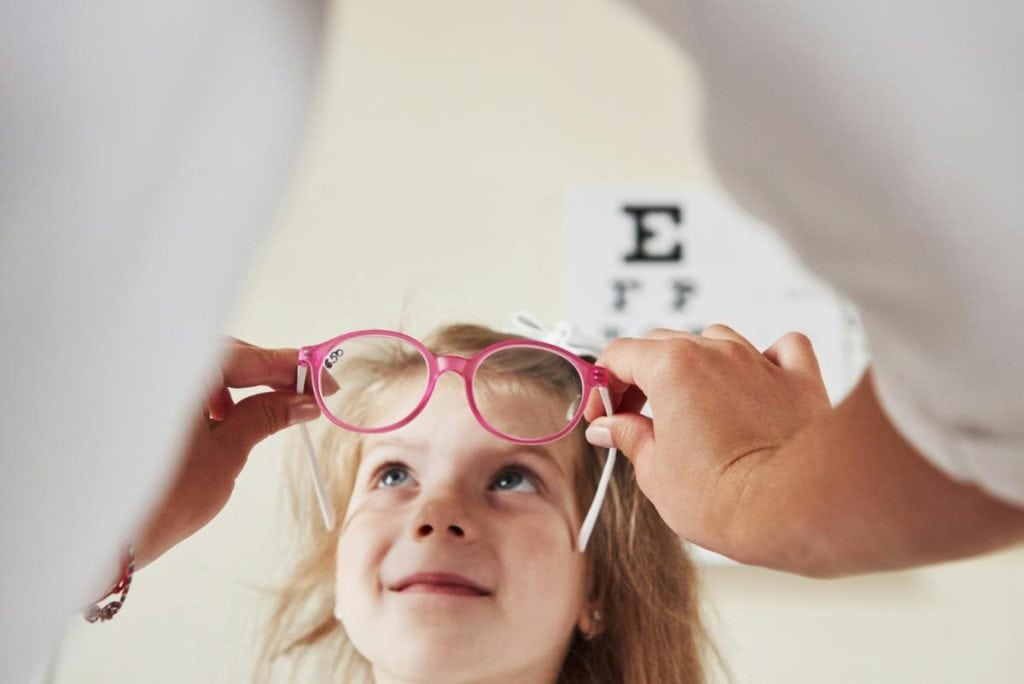Parents are great about looking out for their child’s wellbeing. From noticing bruises and scrapes to noticing that a slight difference in the voice is going to lead to a sore throat, we’re pretty instinctual about these things. But when it comes to vision problems, the signs aren’t always crystal clear.
Good eyesight is critical for a child’s development, affecting everything from learning to social interactions. Think your child may be experiencing vision problems? Here are 8 tell-tale signs that your child might need glasses, helping you catch vision issues early.
The best and easiest way to tell, of course, is by scheduling an appointment with the eye doctor. But in the meantime, these tips can help you pick up on clues that an optometrist visit is in your future.

1. Squinting or Tilting the Head
Does your child squint when looking at distant objects or tilt their head at odd angles while watching TV? These behaviors are often attempts to make their vision clearer. Squinting can temporarily improve focus, while head tilting might help them see better with one eye. If you notice these habits becoming frequent, it’s time to consider an eye exam.
2. Sitting Too Close to Screens
We all know kids love their screen time (a little too much, really), but there’s a difference between enthusiasm and necessity. If your child consistently sits unusually close to the TV or holds tablets and phones right up to their face, it could indicate nearsightedness. The recommended distance for watching TV varies according to screen size, but generally, it should be about 9-10 feet from the screen. For handheld devices, they should be held at arm’s length. If your child can’t see clearly from these distances, they might need vision correction.
3. Frequent Eye Rubbing
It’s normal for kids to rub their eyes when they’re tired. But if you notice your child rubbing their eyes frequently, especially during or after visual tasks like reading or watching TV, it could be a sign of eye fatigue from uncorrected vision problems. However, keep in mind that excessive eye rubbing can also indicate allergies or other eye conditions, so it’s worth investigating further.
4. Difficulty in School or with Reading
Vision and eye health plays a huge role in learning. If your child is struggling in school, especially with reading or board work, poor eyesight could be the culprit. Watch for signs like losing their place while reading, avoiding reading altogether, or complaining that words on the page are blurry. These could all point to vision issues that are interfering with their ability to learn effectively.
5. Complaints of Headaches
Headaches in children can have many causes, but frequent headaches, especially after reading or computer use, can be a sign of uncorrected vision problems. When kids strain to see clearly, it can lead to eye fatigue and headaches. If your child complains of headaches more than once a week, particularly in the forehead or temple areas, consider scheduling an eye exam.
6. Closing One Eye to Focus
Have you noticed your child closing one eye while reading, watching TV, or trying to focus on something? This behavior might indicate that the vision in one eye is stronger than the other. It could be a sign of amblyopia (lazy eye) or other vision problems affecting depth perception. This habit is easier to spot during activities that require focus, like reading or playing video games.
7. Clumsiness or Poor Hand-Eye Coordination
While some kids are naturally more coordinated than others, unexplained clumsiness or difficulty with hand-eye coordination tasks could be related to vision problems. If your child struggles with activities like catching a ball, tying shoelaces, or maneuvering around furniture, it might be worth checking their eyes.
8. Avoidance of Visual Activities
Kids are usually eager to engage in fun activities. If your child starts avoiding tasks that require visual focus, like reading, drawing, or even certain sports, it could be because these activities strain their eyes. Pay attention if they lose interest in hobbies they once enjoyed, especially if those hobbies involve close-up work or distance vision.
What to Do If You Notice These Signs
If you’ve observed one or more of these signs in your child, don’t panic, but do take action. The first step is to schedule a comprehensive eye exam with an optometrist or ophthalmologist who specializes in pediatric care.
Regular eye exams are important for all children, even if they’re not showing symptoms. The American Optometric Association recommends children have their first eye exam at 6 months, another at age 3, and again before starting school.
The Role of Proper Eye Care
Quality eye care is essential for your child’s overall health and development. While most eye care professionals provide excellent care, it’s important to be aware that mistakes can happen. In rare cases where negligence or misdiagnosis occurs, it may be necessary to consult with a legal professional. If you ever find yourself in such a situation, resources are available to help you find an optometrist malpractice lawyer.
Early detection of vision problems can make a world of difference in your child’s life. With proper care and correction, most vision issues can be addressed effectively, allowing your child to see clearly and comfortably. By staying vigilant and proactive about your children’s eye health, you’re setting them up for success in school, sports, and all their future endeavors.
Remember, every child is unique, and these signs may show up differently or not at all. Trust your instincts as a parent. If you feel something isn’t quite right with your child’s vision, get professional advice. Your child’s eyes are their windows to the world – let’s make sure they’re seeing it as clearly as possible.
